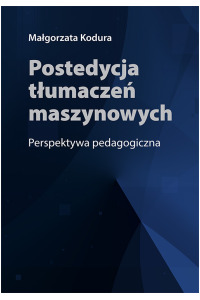 |
Postedycja tłumaczeń maszynowych. Perspektywa pedagogiczna2025 Małgorzata Kodura The central focus is the systematic organization of knowledge about post-editing and, crucially, how to effectively teach this skill to future translators. Key aspects of the publication include:
|
 |
Zastosowanie metod prawnoporównawczych w procesie tłumaczenia2025 Przemysław Kusik The publication addresses the challenge of utilizing comparative law methods (legal comparative studies) in the process of translating legal texts, a topic the author notes is scarcely recognized in existing literature. Key aspects of the study include:
|
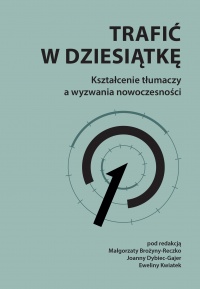 |
Trafić w dziesiątkę – kształcenie tłumaczy a wyzwania nowoczesności
2024 Editors: Małgorzata Brożyna-Reczko, Joanna Dybiec-Gajer, Ewelina Kwiatek The core focus of the book is translator education and the need for it to adapt to the challenges of the modern world. Key themes and topics discussed in the collection of scholarly texts include: contemporary Translation Studies issues: The book addresses current topics in the field, such as: the role of technology in translation, the necessary competencies of a post-editor (working with Machine Translation output), transcreation (creative translation, often for marketing), the translation of picture books; challenges for university translation didactics: A particular emphasis is placed on the challenges facing academic translation teaching, including: the construction of syllabi for translation courses, the role and importance of translation work placements, the education of specialized translators; perspectives of experts: The contributing articles present the world of translation through the eyes of: practitioners and theorists of translation, academic teachers, experts specializing in technical forms of translation. Additionally, the publication serves a dual purpose as it was created to celebrate the 10th anniversary of the Chair for Translator Education at the University of the National Education Commission in Kraków. Therefore, it also provides a solid historical overview of the Chair’s scientific, didactic, and popularizing activities from its inception to the time of the book’s publication. |
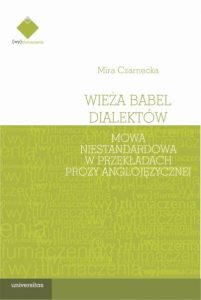 |
Wieża Babel dialektów. Mowa niestandardowa w przekładach prozy anglojęzycznej2022 Mira Czarnecka The book explores the challenges and methods of translating non-standard speech—such as dialects, colloquial language, and the language of minority groups—from English-language prose into Polish. Key points include:
|
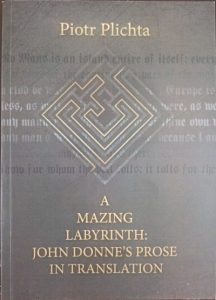 |
A mazing labyrinth: John Donne’s prose in translation2021 Piotr Plichta The main subject of the book is the detailed analysis of select modern translations of John Donne’s major prose works, specifically: Devotions upon Emergent Occasions and Death’s Duell. Beyond the practical analysis of the translations, the book also includes a theoretical investigation. This theoretical part centers on the impact of intersegmental relationships within the text on the practical choices made by the translator. It introduces and elaborates on the author’s theory of “translatorial clef” and “rescript.” In essence, the book explores how the complex structure and meaning of Donne’s challenging prose is negotiated and rendered across different languages, offering both specific examples of translational solutions and a broader theoretical framework for literary translation. |
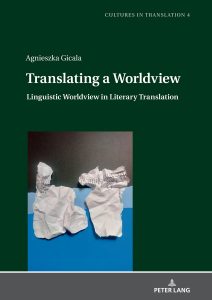 |
Translating a Worldview. Linguistic Worldview in Literary Translation2021 Agnieszka Gicala The book offers a view of the translation of a literary text as a reconstruction of the non-standard linguistic worldview embedded in that text, and emerging from the standard, conventional worldview present in a given language and culture. This translation strategy (and the ensuing detailed decisions) is explained via the metaphor of two icebergs, representing the source and target texts as iceberg tips, resting on the vast foundations of the source and target languages and cultures. This thesis is illustrated by analyses of English translations of two poems by Wisława Szymborska, the 1996 Nobel Prize winner: „Rozmowa z kamieniem“ (Conversation with a Stone/Rock) and „Chmury“ (Clouds).
|
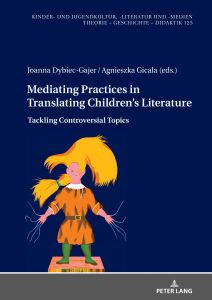 |
Mediating Practices in Translating Children’s Literature: Tackling Controversial Topics2021 Editors: Joanna Dybiec-Gajer, Agnieszka Gicala The goal of the book is to investigate mediating practices used in translation of children’s and young adults’ fiction, focusing on transfer of contents considered controversial or unsuitable for young audiences. It shows how the macabre and cruelty, swear words and bioethical issues have been affected in translation across cultures and times. Analysing selected key texts from Grimms’ tales and Hoffmann’s Struwwelpeter to Roald Dahl’s fiction, it shows that mediating approaches, sometimes infringing upon the integrity of source texts, are still part of contemporary translation practices. The volume includes contributions of renowned TS scholars and practitioners, working with a variety of approaches from descriptive translation studies and literary criticism to translation pedagogy and museum studies. “The angle of looking into the topics is fresh and acute and I whole-heartedly recommend the book for readers from scholars to parents and school-teachers, for all adults taking a special interest in and cherishing children and their literature.” Riitta Oittinen, Tampere University, Finland
|
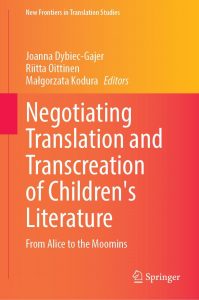 |
Negotiating Translation and Transcreation of Children’s Literature2020 Editors: Joanna Dybiec-Gajer, Riitta Oittinen, Małgorzata Kodura The first book to apply the concept of transcreation to children’s literature in translation Brings together a group of translation scholars, uniquely combining both theoretical expertise and hands-on experience in translating and illustrating for young audiences Provides an indispensable resource for students and scholars in translation studies and children’s literature This book offers fresh critical insights to the field of children’s literature translation studies by applying the concept of transcreation, established in the creative industries of the globalized world, to bring to the fore the transformative, transgressional and creative aspects of rewriting for children and young audiences. This socially situated and culturally dependent practice involves ongoing complex negotiations between creativity and normativity, balancing text-related problems and genre conventions with readers’ expectations, constraints imposed by established, canonical translations and publishers’ demands. Focussing on the translator’s strategies and decision-making process, the book investigates phenomena where transcreation is especially at play in children’s literature, such as dual address, ambiguity, nonsense, humour, play on words and other creative language use; these also involve genre-specific requirements, for example, rhyme and rhythm in poetry. The book draws on a wide range of mostly Anglophone texts for children and their translations into languages of limited diffusion to demonstrate the numerous ways in which information, meaning and emotions are transferred to new linguistic and cultural contexts. While focussing mostly on interlingual transfer, the volume analyses a variety of translation types from established, canonical renditions by celebrity translators to non-professional translations and intralingual rewritings. It also examines iconotextual dynamics of text and image. The book employs a number of innovative methodologies, from cognitive linguistics and ethnolinguistics to semiotics and autoethnographic approaches, going beyond text analysis to include empirical research on children’s reactions to translation strategies. Highlighting the complex dynamics at work in the process of transcreating for children, this volume is essential reading for students and researchers in translation studies, children’s fiction and adaptation studies. |
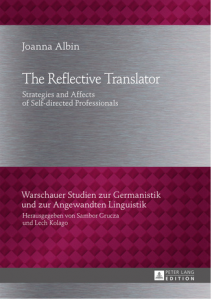 |
The Reflective Translator. Strategies and Affects of Self-directed Professionals2014 Joanna Albin Although university studies do not always provide translators with the necessary skills, many of them continue in their professional capacity, which is understood to be the result of self-directed learning processes. Thus, translators seem to be not only agents of their own education, but also products of translation operations. The data obtained by means of a questionnaire covers three areas: specialisation and the market, qualifications and competence as well as affects and attitudes. Also, a general description of translators’ specific self-directed learning strategies is provided. The results reveal that institutional training has virtually no importance in the professional education of translators and that the skills missed most in their everyday activity are those they failed to acquire by means of self-directed learning procedures.
|
 |
Contrastive Analysis of English and Polish Surveying Terminology2013 Ewelina Kwiatek Newcastle upon Tyne, Cambridge Scholars Publishing This book, with a focus on English and Polish, is a study of surveying terminology, which may be considered as an under-researched area when compared to legal, medical or business terminologies. It examines differences between terms and concepts in the two languages. The purpose of the book is three-fold: firstly, to investigate how surveying terms are created and how they are named in English and Polish; secondly, to analyse concept systems of the two languages with respect to surveying terminology; and thirdly, to indicate the areas of surveying in which terminological and conceptual differences occur, the factors that trigger them and translation strategies which are used to solve them. |
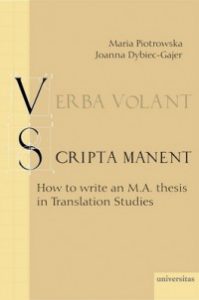 |
Verba volant, scripta manent. How to write an M.A. thesis in Translation Studies2012 Maria Piotrowska, Joanna Dybiec-Gajer The book is aimed at those who want to investigate translation-related problems and write a Master’s thesis that is an academic thesis as part of their second cycle of studies in the European Higher Education Area. This target audience may be enlarged to include Bachelor’s degree students (the first level) for whom certain remarks and chapters in the book will be equally pertinent. The aim of the book is to guide and assist its users at each stage of their research, from identifying an area of interest, through selecting a topic, planning and conducting the research, to submitting their thesis and defending it in a final exam. Students may find it useful for self-study and reference, while teachers and supervisors can use it to enhance their course material. |